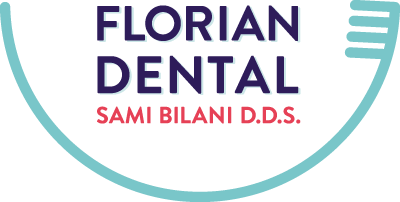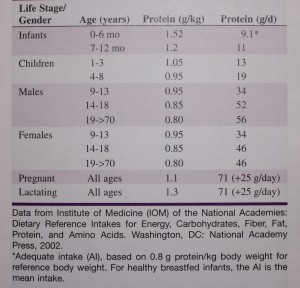Physiological Roles
Proteins perform many important physiological roles. However, protein is not the only important nutrient because others are essential for the body to fully use available protein. Proteins are the principal source of nitrogen for the body and are fundamental components of all body cells. Proteins are necessary for many physiological functions, which can be classified into the following seven categories:
- Generation of new body tissues. Because protein is a constituent of all cells, it is necessary for growth. During periods of increased growth (infancy, childhood, adolescence, and pregnancy) and in periods of wound healing or recovery (illness, surgery, burns, or fever), the need for protein to build new tissues is increased. In some individuals, moderately high protein consumption may stimulate muscle protein growth, favoring retention of lean muscle mass, while improving metabolism.
- Repair of body tissues. Body proteins are continuously being broken down, necessitating their replacement. Assessment of recent and usual protein intake is important.
- Production of essential compounds. Amino acids and proteins are constituents of regulatory enzymes, hormones, and other body secretions. The structural compound collagen is a protein substance of connective tissue that helps support body structures, such as skin, bones, teeth, and tendons. A low protein intake may affect all of these functions.
- Regulation of fluid balance. Protein dissolved in water forms a colloidal solution; in other words, it attracts water. Blood albumin (a protein) draws water from interstitial (space between tissue cells) fluid or cells to maintain blood volume. During protein deficiency, a decreased amount of protein in the blood causes a loss of osmotic balance, resulting in an accumulation of interstitial fluid (edema)
- Residence to disease. Antibodies, or immunoglobulins, the body’s main protection from disease, are proteins. Low protein levels may negatively affect and individual’s immune response, resulting in an inability to fight bacteria and other harmful organisms.
- Transport mechanisms. Proteins enable insoluble fats to be transported through the blood.
- Energy. When the nitrogen grouping is removed, the remaining carbon skeleton can be used for energy, furnishing 4 kcal/g. Although this is not one of its main functions, protein is used in this manner when (a) caloric intake from carbohydrate and fat is inadequate, (b) protein intake exceeds requirements, and (c) essential amino acids (EAAs) are unavailable for synthesis of proteins.
REQUIREMENTS
Protein requirements for health are based on body size and rate of growth. (The body needs more protein during growth periods or for maintenance and repair of a larger body mass.) To a certain extent, the better the quality of protein (higher PDCAA score), the less quantity is required. Protein requirements are based on the assumption that EAAs and kilocalories are provided in adequate amounts.
(Protein digestibility corrected amino acid (PDCAA) is the official method of evaluating protein quality for humans. It is based on amino acid requirements of young children and corrects for digestibility. Vegetable and some grain proteins are less well digested than animal protein, partly because the protein is encased in cell walls that make it less available to digestive enzymes. Vegetables and grains contain all the EAAs, but because one or more EAAs are present in a very low ratio, the protein they finish has a low PDCSS score.)
The recommended dietary allowances (RDAs) for protein vary proportionately for different ages and stages of life to adjust for growth rates. The Institute of Medicine (IOM) has determined the daily minimum requirement of protein for adults is about 0.6 g/kg. Using 0.6g/kg, a patient weighing 150 lb (68.2kg) would require 41 g of protein. Because RDAs provide a margin of safety, the IOM has established 0.8g/kg daily as the RDA. With this standard, a patient weighing 150 lb (68.2 kg) requires 56 g protein. The RDAs for protein for various stages of life are listed below.
Based on the National Health and Nutrition Examination Survey (NHANES), 2003-2004 data, protein intake averaged approximately 91g in adults 19 to 39 years old, and decreased to about 66 g/day in elderly adults. This represents approximately 15% of total kilocalories, within the recommended amount of acceptable macronutrient distribution range (AMDR) of 10% to 35%. Males consume more protein than females. Approximately 7% to 8% of adolescent girls and 7.2% to 8.6% of elderly women consume protein levels below their estimated average requirement. Very few individuals consume protein amounts close to the highest AMDR of 35% for their age/sex group.
Recent research indicates many adults may benefit from eating more than the minimum requirement, and investigators have requested that the IOM revisit protein recommendations. The conclusions of the Protein Summit in 2007 were presented in the May 2008 Supplemental issue of the American Journal of Clinical Nutrition. Findings presented indicate higher protein diets are linked with a lower risk of chronic diseases, such as type 2 diabetes, coronary heart disease (CHD), and osteoporosis, and sarcopenia. Sarcopenia is the loss of muscle mass and strength with aging, a condition many believe is normal for elderly individuals.
The conclusion of the investigators at the Protein Summit was that overweight or obese and older Americans may benefit by consuming 35% of their kilocalories from protein. It was also recommended that the revised 2010 Dietary Guidelines for Americans address protein as a required nutrient.
When any condition of health or disease causes a significant protein loss, an increased protein intake (grater than the RDAs) prevents excessive loss of tissue and plasma proteins. Although these stares increase protein requirements, RDAs have not been established for these conditions. Providing additional amounts for supplementation with high-quality proteins can help prevent protein malnutrition and shorten recovery periods. While updating the macronutrients in 2002, the IOM reviewed scientific evidence for protein requirements for healthy adults undertaking resistance or endurance exercise. They found no compelling evidence for additional protein requirements, especially because Americans commonly ingest significantly more protein than is recommended.
Ordinarily, dietary protein is restricted only in some physiological disease states affecting the liver and kidney because these organs are heavily involved in protein use and excretion of protein waste products. If the liver and kidney are diseased, excessive amounts of protein cannot be properly handled without further organ damage.
SOURCES
Foods with a high protein content are readily available in the United States. Meat and milk food groups furnish most of the protein. Soy is a good source of protein and has other health benefits. An increased intake of cereal products boosts protein intake. The protein content of items from the sample menu displayed bellow.
Food Quantity Protein (g)
| Chicken, light meat, cooked | 2 oz | 20 |
| Chicken, dark meat, cooked | 2oz | 18 |
| Pork chops lean, cooked | 2oz | 16 |
| Beet, cooked, lean cuts | 2oz | 15 |
| Pinto beans, cooked | 1 cup | 15 |
| Cottage cheese | ½ cup | 14 |
| Cheddar cheese | 2oz | 14 |
| Cod fish, cooked | 2oz | 13 |
| Egg, hard cooked | 2 | 13 |
| Thick milkshake | 11 oz | 12 |
| American processed cheese | 2oz | 10 |
| Milk, whole, reduced fat, or low fat | 1 cup | 10 |
| Peanut butter | 2 Tbsp | 8 |
| Nonfat dried skim milk powder | 1/3 cup | 8 |
| Macaroni, cooked | 1 cup | 7 |
| Oatmeal, cooked | 1 cup | 6 |
| Rice, white, cooked | 1 cup | 4 |
| Rice, brown, cooked | 1 cup | 5 |
| Ice cream, l0% fat | 1 cup | 5 |
| Corn muffin, small | 1 | 4 |
| Enriched white bread | 1 slice | 2 |
| Vegetables | ½ cup | 1-2 |
| Fruits | ½ cup | 0.1-1 |
Depending on sex, size, and activity level, MyPyramid recommends 5 to 7 oz of cooked lean meat, poultry, or fish daily for adults. About 3 Tbsp of chopped/ground meat, or the size of a small matchbox, equals 1 oz of meat; a small chicken drumstick or thigh is equivalent to 2 oz of meat; and a deck of cards or the size of your palm is approximately 3 oz. One-half cup, or the amount that can fit in a cupped hand, of beans or 1 Tbsp of peanut butter (size of a ping pong ball) can be substituted for 1 oz of meat. In most cases, digestibility and nutritional value are favorably affected by cooking procedures. Proper cooking sometimes facilitates digestion and use. Cooking makes egg albumin more readily digestible, and cooking soybeans increases amino acid bioavailability. Bioavailability indicates the amount of nutrient available to the body after absorption. Processing affects proteins in cereal by binding lysine (an amino acid), making it unusable by the body.
DENTAL HYGIENE CONSIDERATIONS
- Most Americans consume almost twice as much protein as
recommended in the RDAs. - When assessment indicates a normal consumption of 1.5 g/
kg or more above the RDA for protein, this is considered a
high-protein diet. Further increases may not be beneficial and
may contribute to increased fat stores and dehydration. - An inadequate protein intake could affect any or all of the
physiological functions of protein in the body. - Assessment of protein intake of patients with periodontal
issues is especially important. Protein deficiencies may com-
promise the physiological systemic response to inflamma-
tion and infection, and periodontal problems may increase,
the protein requirement to promote healing in patients with
inadequate or marginal protein intake. - One rule of thumb is protein should provide 10% to 35% of
caloric intake. If protein intake seems inappropriate, determine
caloric or protein intake or both. The adequacy of intake can be
established by using one of two methods. As an example, based
on consumption of 2200 kcal/day, the amount of protein based
on total energy intake is calculated as follows:
2200kcal x 0.35 (maximum recommended % of total kilocalories from protein) =
770 kcal from protein or less
770kcal / 4 (kcal/g protein) = 193 or less of protein recommended
The intake of 193 g of protein is the highest level recom-
mended. Because 35% is the upper limit, protein consump–
tion above this level may jeopardize adequate intakes of
nutrients provided from other food sources.
For the second method for calculating, if protein intake is 55 g,
and caloric intake is 2200 kcal, the percentage of protein based on
the actual protein intake can be determined as follows:
55 (g protein) x 4 (kcal/g protein) =
220 kcal from protein
220(kilocalories from protein) / 2200
(total kilocalorie intake)x 100(%) =
10% of total kilocalories from protein
Because 10%r is the lower limit, this person’s protein may
be inadequate, and professional counseling may be war-
ranted. Person should see a registered dietitian.
To be continued…

